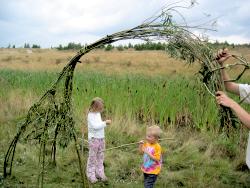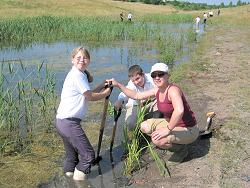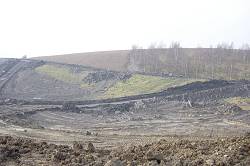Ollerton Pit Wood


The Nottinghamshire colliery tip sites were restored by Nottinghamshire County Council, in partnership with the Forestry Commission, through the ‘Greening the Coalfield’ project. The two organisations and Sherwood Forest Trust then agreed to work together to manage the sites, including the provision of Community Rangers to facilitate local involvement in the management of the sites.
The project has worked with a wide variety of local schools, groups and individuals including approximately 1000 volunteer days per year and 500 school pupil visits per year.
There are seven former colliery tip sites plus several other local countryside sites, each with an area of approximately 50 to 150 ha. The sites are mostly coniferous, but there are also areas of broadleaf woodland, open water and grass or heathland. Former pit sites were planted with Woodland Grant Scheme funding (granted to Nottinghamshire County Council), which required a high percentage of conifer plantation. Sites are now being managed to redress the balance as far as possible, without affecting the grant.
Sites managed by Forestry Commission:
Sites managed by other organisations, with ranger services provided by Forestry Commission:
The Sherwood Forest Community Rangers project received funds of approximately £450,000 from CRT, Alliance Sub-regional Strategic Partnership and Heritage Lottery Fund. Funding was obtained in spring 2001 and four Community Rangers were employed from summer / autumn 2001.
The funding for this project ended in March 2006, but the Forestry Commission continues to carry out the community involvement work that the project began. This includes service level agreements with other local organisations, enabling the rangers to work on an area wide remit, rather than just on Forestry Commission sites.
 Aims and achievements
Aims and achievementsThe South Yorkshire Coalfields Restoration project has been undertaken and managed by the Sherwood and Lincolnshire Forest District.
This project started in 2001 and by the end of 2005 was responsible for the successful restoration of over 400 hectares of brownfield land. The sites consist of a mixture of:
In addition to urban greening, the objectives of the project are to encourage community engagement, conservation management and social enterprise, provide a recreation and educational resource as well as commercial timber production.
On the majority of the sites, the restoration has been funded by the regional development agency, Yorkshire Forward, through English Partnerships. The land ownership has then passed to the Land Restoration Trust who fund the Forestry Commission to manage and maintain the site through a dowry from English Partnerships.
The exception is Edlington Colliery, where the site restoration was funded through a coal washing scheme by Odgens in conjunction with the Forestry Commission and Doncaster Metropolitan Borough Council. The ongoing maintenance and management are funded jointly by the Forestry Commission and Doncaster Metropolitan Borough Council.